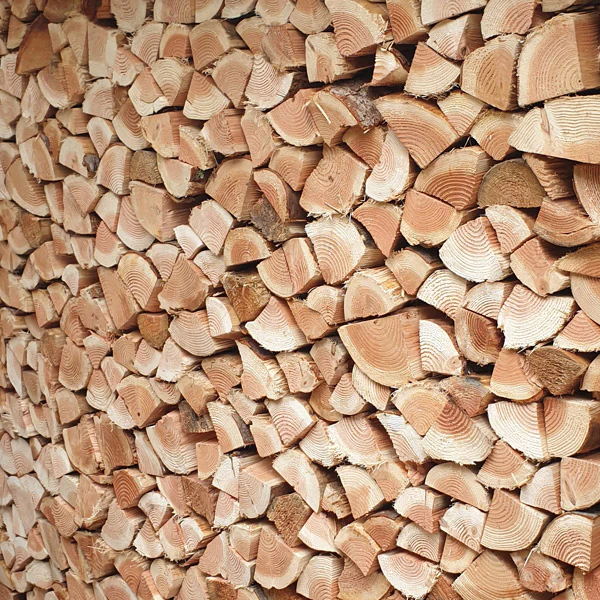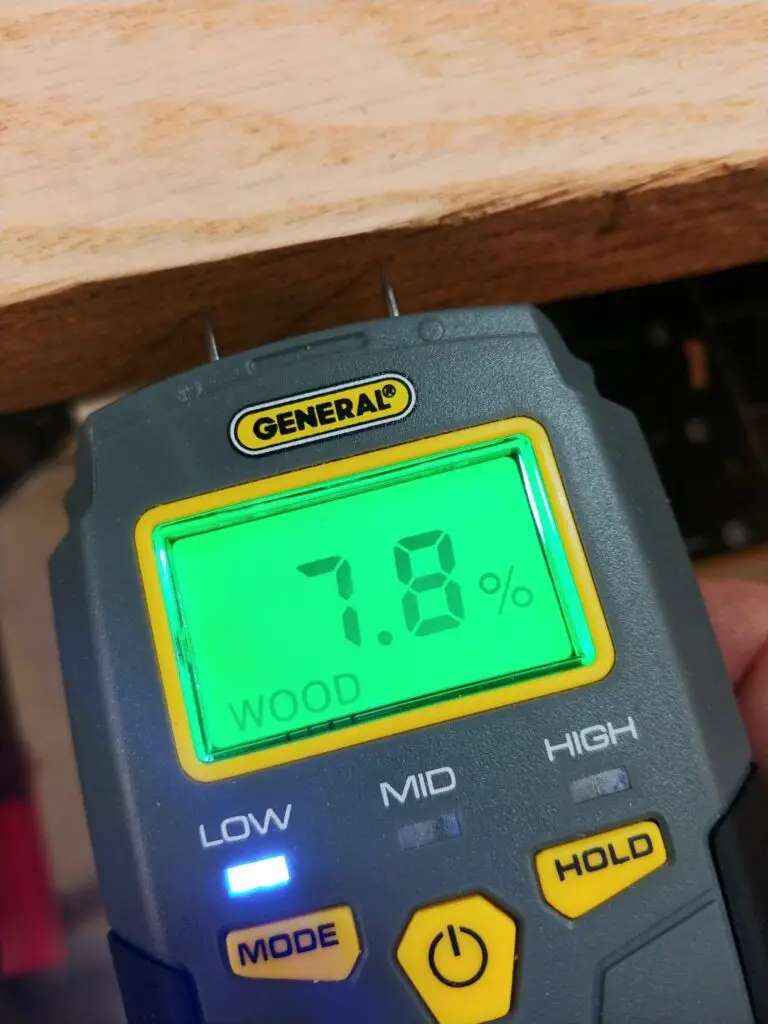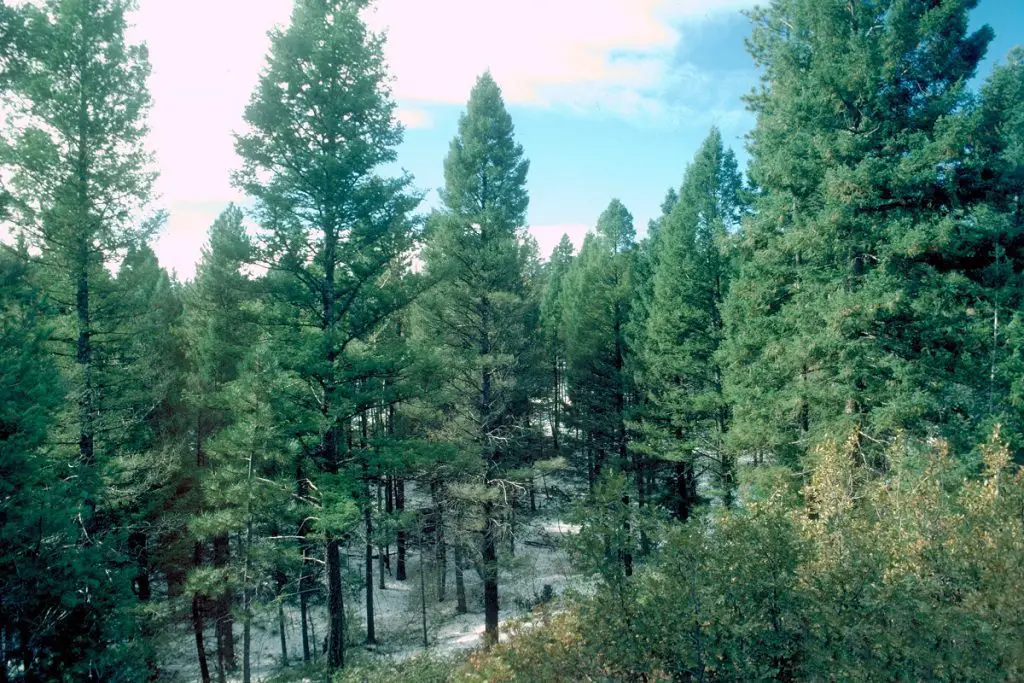Douglas Fir is moderate but popular firewood throughout the Western United States and Canada due to its availability, large yields per tree, and decent heat production for a softwood. However, it does have some key downsides – it generates a lot of smoke, requires at least 12 months to fully season its high sap content, and splinters when chopping.
Having said that, Douglas Fir is good firewood for burning outdoors and is one of the better softwood firewood options. Let’s explore each of these criteria more thoroughly individually.
Table of Contents
Summary
- BTU: 20.7 million BTU/cord
- Weight: 3300 lb/cord green
- Seasoning Time: 12 months
- Splitting Difficulty: Low
- Sap Content: Low
- Smoke: Lots
- Smell: Low
Overall, Douglas Fir is one of the better softwood species with high heat production, it is easy to split, has a high yield per tree, and has a slight smell.
However, it does produce a lot of smoke and creosote that needs to be cleaned from your chimney and takes a bit longer to season at 12 months.
Compared to the top-tier firewood like Oak and Maple, Douglas Fir does not compare.

Heat Production
Douglas Fir produces one of the highest heat productions of any softwood at 20.7 million BTU/cord. Although this is substantially lower than the premium-tier hardwoods at 27-28 million BTU/cord. You should note that you will need to stockpile an additional 25% of Douglas Fir to produce the same amount of heat all winter low compared to Burr Oak.
Smoke Production
Douglas Fir firewood does produce a lot of smoke due to its sap content. This makes it less desirable to burn indoors. I generally limit it to burning as kindling indoors but will happily burn it as the primary fuel source outside in a fire pit or campfire.
Seasoning Time
Douglas Fir does take longer to season than other softwood varieties and takes 12 months to dry. This is particularly important to eliminate as much sap as possible. This will significantly reduce the smoke generation from lower sap concentration. I strongly recommend fully seasoning all firewood before you burn it to maximize the heat efficiency, but for Douglas Fir this is particularly critical.
I personally recommend this General Tools Moisture Meter. It allows you to accurately gauge how wet your firewood is and whether it is sufficiently seasoned. Over time you can also see how quickly the moisture is dropping and how much longer you need to keep your firewood dropping until it is seasoned and ready to burn.
Press the sharp pins into the wood and you will quickly see the readout show the moisture ranging from 5% to 50%. It also has a Low/Mid/High indication depending on whether the wood is dry enough, so you don’t need to remember the actual values.

Burning Smell
Surprisingly with its high smoke generation and sap content, Douglas Fir doesn’t have a particularly strong smell. It is similar to pine and cedar but not as powerful. I wouldn’t hesitate to burn Douglas Fir in a household with people sensitive to scents.
However, I love the smell of Douglas Fir when chopping and drying it.
If you are especially interested in odor for smoking meats or if you are sensitive to smell, have a read through this guide I have written about the best smelling firewoods to burn.
Creosote Buildup
Creosote is a black soot buildup that occurs in your chimney from unburnt softwood. It is particularly worrying because creosote can catch fire if enough builds up, causing chimney fires. I recommend cleaning your chimney regularly regardless of the type of wood your burn.
Douglas Fir does produce creosote because it is a softwood. It is essential to fully dry the wood before burning it to help remove as much moisture and sap as possible. This is one of the key downsides of using softwood as a primary source of fuel. I will always prioritize a hardwood as my main fuel source and only use softwood for kindling.
Splitting
Douglas fir is softwood and splits very easily. It grows tall and straight without significant knots so processing a full tree yields a lot of good-sized firewood. The only downside is that it tends to splinter, so wear gloves and eye protection when splitting. It has some sap content but nothing compared to pine – however, you should clean your chainsaw or splitting axe thoroughly before storage to minimize corrosion.
You will need to limb a lot of branches to access the trunk, particularly as you get further up towards the top.
Different Types/Species
Douglas Fir is not a ‘true’ fir tree. It can reach over 200 feet tall and 5 feet in diameter. They are the second tallest tree in the world, just after the Coasted Redwood. You will often find Douglas Fir growing with other conifers, like Cedar and Hemlock.
Coastal Douglas Fir
Their distribution is from British Columbia in the north to the Pacific Coast Range in Central California in the south. Also known as the Oregon Pine or Douglas Spruce, they grow in elevation ranges of 0 to 6000 feet. They are fast-growing trees, with the largest specimen found at 465 feet (source).
Rocky Mountain Douglas Fir
Also known as Interior Douglas Fir, they are found from British Columbia to southwest Alberta and even into northern Mexico. They grow between 2000 to 10,000 feet of altitude. The Rocky Mountain Douglas Fir can live more than 500 years and grow more slowly than its Coastal cousin.

Comparison to Other Woods
Here, I’ve taken some of the most popular firewoods to burn indoors and compared them to douglas fir firewood.
Comparing Douglas Fir to the top hardwood firewood is a bit unfair. Its main downside is the smoke generation and the creosote buildup. These two issues in combination make it much less suitable for burning indoors than some other species.
| Firewood | Million BTU/Cord (source) | Ease of Splitting | Coals | Overall Quality |
| Green Ash | 20 | Easy | Good | Excellent |
| Maple | 25 | Easy | Excellent | Excellent |
| Bur Oak | 26 | Easy | Good | Excellent |
| Douglas Fir | 21 | Easy | Good | Moderate |
Douglas Fir is a top-quality softwood firewood, but simply doesn’t compare to hardwoods. I can only rate it as ‘Moderate’ in terms of the overall score.
FAQs
Can you burn douglas fir wood in a fire pit?
Yes, douglas fir is ideal for burning outdoors at your campsite. It burns hot and is widely available. It does produce a lot of smoke, so you may need to shuffle your chairs away from the downwind position.
Can you burn douglas fir wood in a wood stove?
Yes, you can burn douglas fir indoors, although it generates more smoke than popular hardwood firewood. Douglas Fir also produces creosote because it is a softwood, so you should clean your chimney regularly. I will burn Douglas Fir indoors, but I prefer to use it as kindling.
How much does douglas fir firewood cost to buy?
Douglas Fir is widely available throughout the West Coast of the United States and costs significantly less than the premium hardwoods. A cord of Douglas Fir will cost between $150 and $200 per cord, depending on the season and your location.
Final Thoughts
Douglas Fir has some great quality as a firewood. Its heat production is one of the highest for any softwood species, it is easy to split, seasons within a year, and produces good quality coals. However, it does generate a lot of smoke, forms creosote in the chimney, and has a high sap content. Each tree produces a high firewood yield that is easy to process without the need for heavy machinery like a hydraulic log splitter.
